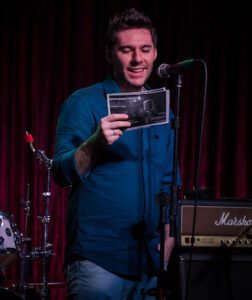Is there a middle ground between SOME opera “dinosaurs” (who consider that breathing right is 90% of singing) and the radicals that suggest from the 1970s onwards (who consider that the way you breathe to sing must be the way you breathe to talk)?
Yes definitely! Modern methods, such as the ones we use as a basis here in the studio (the main one being Brett Manning’s Singing Success) present a nice balance between these two extremes that we talked about above. We do have to work on breathing, but we can’t think that ONLY that is enough to sing well.
To the people of the opera, we can say that there are several problems that cannot be solved simply with breathing. A very common mistake they make, for example, is asking someone with a certain breathiness in their voice to “support”. I put it in quotation marks because I don’t like it when that term comes without the proper definition.
Support would be to use in a conscious and controlled way the trapping and air flow process during the act of singing or speaking. In general, we do not use the term in the studio (unless precisely defined) so as not to confuse students who have taken classes elsewhere or those searching the internet. The problem with the word support is that it has become an easy fix that some teachers apply to ALL voice problems.
In our example of the person who sings with a little breathiness, the problem, in general, is that the vocal folds are not working properly (they are not approaching – or adducting – as they should during vibration movement). The best solution for this person would be exercises that correct this movement of the folds and not breathing exercises.
And what about the other extreme? To the radicals who emerged from the 1970s? Well, although some of them have a lot of merit in demystifying many things that were crystallized in the teaching of singing through opera, here they are not 100% correct. Simply because although the act of singing uses basically the same musculature as the act of speaking, singing places a much greater demand on our body.
So what’s the solution? Work in a balanced way breathing exercises and vocal exercises that do not directly involve breathing . Therefore, the function of the vocal coach is very important to correctly diagnose the problem and propose the exercises and the time that the student should train for each subject.
Singing is an act that involves some kind of constriction (fancy name for squeezing). No matter how relaxed you are or how soft you sing, there will always be some degree of constriction. Breathing then serves to balance this normal vocal musculature constriction system when singing.
After some time of experience, you learn, as soon as you sing a passage, to ask yourself: should I use more pressure (constriction) or more air flow? If there is too much constriction in the act of singing, you may simply not be able to sing at all or be injured in the process. If there’s too much airflow, your voice may be weak and breathy.
What I said above is simply the technical point of view. We must also consider these aspects from the point of view of style. Rock singing for example, in general, involves more pressure than singing MBP; if you want to explore other vocal registers (like falsetto) you’ll have to use more airflow; and so on.
The final message (especially to those who don’t take classes with us) is to be suspicious if you hear someone talking about breathing (and support) as a solution for EVERYTHING or that specific breathing exercises are useless!
Yes definitely! Modern methods, such as the ones we use as a basis here in the studio (the main one being Brett Manning’s Singing Success) present a nice balance between these two extremes that we talked about above. We do have to work on breathing, but we can’t think that ONLY that is enough to sing well.
To the people of the opera, we can say that there are several problems that cannot be solved simply with breathing. A very common mistake they make, for example, is asking someone with a certain breathiness in their voice to “support”. I put it in quotation marks because I don’t like it when that term comes without the proper definition.
Support would be to use in a conscious and controlled way the trapping and airflow process during the act of singing or speaking. In general, we do not use the term in the studio (unless precisely defined) so as not to confuse students who have taken classes elsewhere or those searching the internet. The problem with the word support is that it has become an easy fix that some teachers apply to ALL voice problems.
In our example of the person who sings with a little breathiness, the problem, in general, is that the vocal folds are not working properly (they are not approaching – or adducting – as they should during vibration movement). The best solution for this person would be exercises that correct this movement of the folds and not breathing exercises.
And what about the other extreme? To the radicals who emerged from the 1970s? Well, although some of them have a lot of merit in demystifying many things that were crystallized in the teaching of singing through opera, here they are not 100% correct. Simply because although the act of singing uses basically the same musculature as the act of speaking, singing places a much greater demand on our body.
So what’s the solution? Work in a balanced way breathing exercises and vocal exercises that do not directly involve breathing. Therefore, the function of the vocal coach is very important to correctly diagnose the problem and propose the exercises and the time that the student should train for each subject.
Singing is an act that involves some kind of constriction (fancy name for squeezing). No matter how relaxed you are or how soft you sing, there will always be some degree of constriction. Breathing then serves to balance this normal vocal musculature constriction system when singing.
After some time of experience, you learn, as soon as you sing a passage, to ask yourself: should I use more pressure (constriction) or more airflow? If there is too much constriction in the act of singing, you may simply not be able to sing at all or be injured in the process. If there’s too much airflow, your voice may be weak and breathy.
What I said above is simply the technical point of view. We must also consider these aspects from the point of view of style. Rock singing for example, in general, involves more pressure than singing MBP; if you want to explore other vocal registers (like falsetto) you’ll have to use more airflow; and so on.
The final message (especially to those who don’t take classes with us) is to be suspicious if you hear someone talking about breathing (and support) as a solution for EVERYTHING or that specific breathing exercises are useless!





